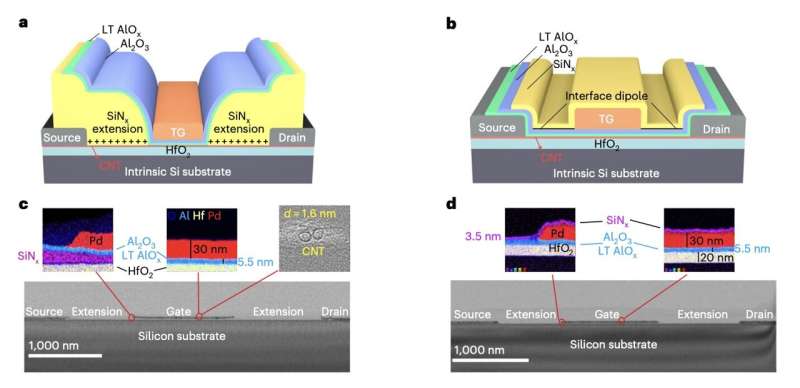November 10, 2023 feature
This article has been reviewed according to Science X's editorial process and policies. Editors have highlighted the following attributes while ensuring the content's credibility:
fact-checked
peer-reviewed publication
trusted source
proofread
Carbon nanotube–based MOSFETs doped using a scalable technique

In recent years, electronics engineers have been trying to identify materials that could help to shrink the size of transistors without compromising their performance and energy efficiency. Low-dimensional semiconductors, solid-state superconducting materials with fewer than three spatial dimensions, could help to achieve this.
Among low-dimensional semiconducting materials that have been found to be particularly promising for reducing the length of gates inside transistors are one-dimensional (1D) carbon nanotubes. Nonetheless, most proposed strategies to dope these materials and control the polarity inside them are not compatible with existing large-scale electronics production methods.
Researchers at the University of California, San Diego, and the Taiwan Semiconductor Manufacturing Company recently developed new carbon nanotube metal-oxide- semiconductor field-effect transistors (MOSFETs) with localized solid-state extension doping. These transistors, presented in Nature Electronics, achieve remarkable performances, yet their polarity can be advantageously controlled using a strategy compatible with existing complementary-metal-oxide-semiconductor (CMOS) doping processes.
"We report top-gate complementary carbon nanotube MOSFETs in which localized conformal solid-state extension doping is used to set the device polarity and achieve performance matching," Zichen Zhang, Matthias Passlack and their colleagues told Tech Xplore.
"The channel of the transistors remains undoped, providing complementary metal–oxide–semiconductor-compatible n- and p-MOSFET threshold voltages of +0.29 V and −0.25 V, respectively. The foundry-compatible fabrication process implements localized charge transfer in the extensions from either defect levels in silicon nitride (SiNx) for n-type devices or an electrostatic dipole at the SiNx/aluminum oxide (Al2O3) interface for p-type devices."
The researchers tested a prototype of their carbon nanotube-based devices in a series of tests. They also compared the results of these experiments with requirements that have been set for future scalable MOSFETs.
Although the researchers are still in the early stages of development and testing of their proposed transistors, they already achieved very promising results. Notably, the performance of the transistors was found to be comparable to that of other previously reported MOSFETs based on low-dimensional semiconductors, yet they are also compatible with existing CMOS technology, thus they could be easier to upscale in the future.
"We observe SiNx donor defect densities approaching 5 × 1019 cm−3, which could sustain carbon nanotube carrier densities of 0.4 nm−1 in the extensions of scaled nanotube devices," Zang, Passlack and their colleagues wrote in their paper. "Our technique is potentially applicable to other advanced field-effect transistor channel materials, including two-dimensional semiconductors."
The new transistors created by the team could contribute to the future creation of smaller, highly performing and scalable electronics based on 1D carbon nanotubes. The researchers plan to continue improving and testing their transistors, with the hope of finalizing their design by 2031.
"We fabricated top-gate complementary CNT MOSFETs for which the devices' polarity is set and performance matching is accomplished exclusively by localized conformal solid-state extension doping, a module that is compatible with CMOS foundry resources," the researchers concluded in their paper. "Localization of doping to extensions only is an important aspect of this approach and reduces device-to-device variability in a short-channel device as dopant fluctuations are a substantial source of variability."
More information: Zichen Zhang et al, Complementary carbon nanotube metal–oxide–semiconductor field-effect transistors with localized solid-state extension doping, Nature Electronics (2023). DOI: 10.1038/s41928-023-01047-2
© 2023 Science X Network




















